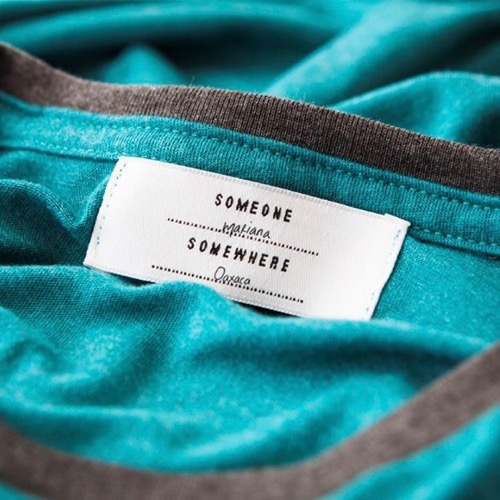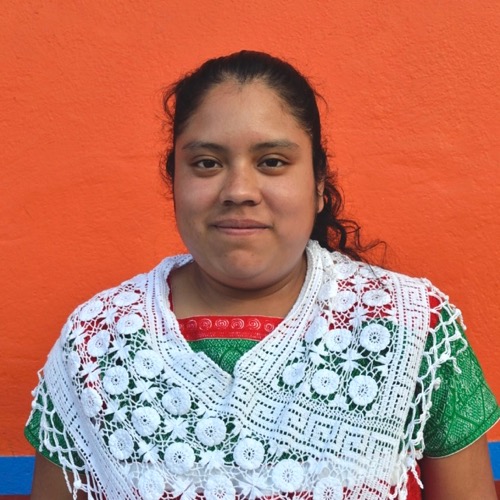Five women stepped forward from among the dozens of seamstresses and artisans from the village of Naupan, tucked away among the mountains of the Mexican state of Puebla. The rest chose to wait.
Fashion startup Someone, Somewhere was visiting Naupan from Mexico City to strike up partnerships with the local seamstresses and artisans, providing jobs and creating contemporary fashion that embraced traditional Mexican textiles.
Petra Secundino, 37, was one of the first to sign on. “It was totally unexpected for me to find something like this that allows me to work from home,” she says. In many Mexican rural communities, women can struggle to find employment, either because of limited access to jobs or because of social pressure to remain at home.
Secundino remembers the division of the community when the “group of youngsters”—Someone, Somewhere’s three 20-something cofounders—came to the village to pitch the idea and how the balance began to shift.
“We started with one order, then two, then three, then four,” she says. “As we began ramping up with more designs, the friends, the cousins started being interested and asking to get involved.”

Since starting out with those first five artisans, Someone, Somewhere has grown to employ 162 people across Mexico, providing much-needed income for its predominantly female workforce. Three thousand more have contacted the company asking to join.
Someone, Somewhere employs 162 people across Mexico, providing much-needed income for its predominantly female workforce.
Mexico’s National Fund for the Development of Arts and Crafts estimates that eight million artisans live in Mexico, a majority of them below the poverty line. Cofounder and CEO of Someone, Somewhere José Antonio Nuño, 26, first came to the village from Mexico City as a teenager to volunteer with his friends.
“After several years of volunteering, my partners and I decided to do something more sustainable for the community [after we graduated college,]” Nuño says. “We realized the levels of poverty and marginalization, but [also] the beauty of the crafts produced there.”

Nuño saw one potential reason for why so many artisans lived in poverty: They were producing decorative souvenirs that had been popular 30 years ago—like sombreros and skull ornaments—instead of products that resonated with today’s market, such as T-shirts, sweaters, backpacks, and hats.

Pieces in the Someone, Somewhere line incorporate traditional textiles, like a woven patch on a T-shirt, a bold pattern on a pair of swim trunks, or a geometric shape stitched onto a denim shirt. Each item comes with a label naming the artisan and her community, creating a thread between creator and consumer.
Fresh off a win at the Mexico City Creator Awards, a WeWork-sponsored competition funding ideas with impact, Nuño says he’s now ready expand, starting with Mexico’s neighbor to the north, the U.S.
Empowering with income
Naupan is one of hundreds of rural villages in Mexico that lives off the textile industry because it’s one of the only options besides agriculture. When Nuño and his cofounders struggled at first to get a single artisan to join their vision in Naupan, they learned of the village’s troubled history with outside partners.
“Other designers had come to promise they would change the world for these women, even release their collections in New York,” he says. “Some women bought new looms and other equipment, but the people never came back.”
Someone, Somewhere built up trust, artisan by artisan, who started to see income from the partnership right away. “Once people saw we returned regularly, interest grew,” he says.
Since production got underway in 2016, the company has sold between 5,000 to 8,000 T-shirts a year, along with around 3,000 sweaters, 2,000 hats, 2,000 backpacks, and 1,000 swimsuits. The company distributes the line via e-commerce and pop-up stores in Mexico City.

Nuño estimates that the company has at least tripled the income of the women they work with. One seamstress, Silvina Alvarez Flores, is paralyzed except for movement in her hands. Previously, Flores depended on her aging grandmother to take care of her. Now she brings in her own income, sewing from her bedroom.
“We always seek to integrate those with the greatest need, such as single mothers or those from the poorest families,” Nuño says, adding that Flores has become the biggest earner in her family and is able to send her nieces and nephews to school.


Secundino echoes this, saying that she has also become the breadwinner in her household. She recalls some initial pushback from males in the community when the women started to earn their own incomes.
“Sexism reared its ugly head,” she says. “But the advantages of working from home, allowing women to still do what they need to do there, and of bringing in more money has convinced those who were opposed.”
Refining their style
“When we started, we were only engineering students,” Nuño admits. “We had no idea about design.”
He describes the company’s first “ugly” designs—patches ironed onto pre-existing clothing. The team now includes 15 fashion, textile, and industrial designers who follow current trends and coordinate with the artisans.
A startup vibe permeates the company offices. Located in a converted residential bloc in Mexico City’s hip neighborhood of Roma, the headquarters is half occupied by long tables covered in swatches of material. The glass walls of the meeting room are covered in marker scribbles, names of communities melding with items and deadlines. At the back, the trends laboratory is filled with racks of clothing and a gigantic sewing machine, which Nuño says can crank out any new idea as quickly as possible.
“We always release products in small quantities to test them out,” Nuño says. “If they work, we do more.”
A lesson in localization
As Someone, Somewhere has developed as a business, one of the biggest missteps came when they built a central workshop in Naupan with the idea of serving as a base for the artisans to learn how to make products.
“It was a total failure,” Nuño says. “The women wanted to work from home and maintain their activities, such as cooking or childcare.”
Now when Someone, Somewhere works with communities across central and southern Mexico, the company strives to preserve the lives of the artisans. Local coordinators in each community, including Secundino, are in constant touch with Nuño and ensure his team understands any local issues.
“I still sew, but less and less, as my time is taken up by the coordination,” Secundino says. Her duties regularly include accounting, distributing the workloads, ensuring quality control, and sending the goods to Mexico City.
One million artisans

So what’s next for Someone Somewhere? Nuño says he’ll capitalize on interest from the U.S., the source of 10 percent of the company’s online traffic. This summer, the company will open a pop-up store in Venice Beach, CA. Over time, the store will test new concepts such as wallets, passport holders, and even surfboards designed with Ceviche Surf Co., fellow winners at the Mexico City Creator Awards.
Nuño believes that if demand explodes in the US, the number of women employed will skyrocket.
“Our intention is to reach 1,000 artisans in the next year,” he says. “We want to continue expanding dramatically. In the best scenario, we would eventually reach 500,000 to 1 million artisans.”
One million, following in the footsteps of just five.







